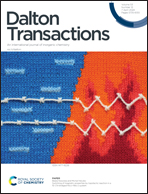Re(i)[2-aryl-1H-imidazo[4,5-f][1,10]phenanthroline] tricarbonyl chloride complexes for selective cancer therapy via a potential DNA damage mechanism†‡
Abstract
Recently, achieving selective cancer therapy with trifling side effects has been a great challenge in the eradication of cancer. Thus, to amplify the cytoselective approach of complexes, herein, we developed a series of Re(I)[2-aryl-1H-imidazo[4,5-f][1,10]phenanthroline] tricarbonyl chloride complexes and screened their potency against HeLa and MCF-7 cell lines together with the evaluation of their toxicity towards a normal kidney cell line (HEK-293). On meticulous investigation, complex [ReI(CO)3Cl(K2-N,N-(2c))] (3c) was found to be the most potent anticancer entity among other complexes. Complex 3c also showed competency to induce apoptosis in MCF-7 cells through G2/M phase cell-cycle arrest in association with the generation of ample reactive oxygen species (ROS), eventually leading to DNA intercalation and internucleosomal cleavage. The order of the cytotoxicity of these complexes depended on their lipophilic character and the electron-withdrawing halogen substitution at the para-position of the phenyl ring in the imidazophenanthroline ligand.
![Graphical abstract: Re(i)[2-aryl-1H-imidazo[4,5-f][1,10]phenanthroline] tricarbonyl chloride complexes for selective cancer therapy via a potential DNA damage mechanism](/en/Image/Get?imageInfo.ImageType=GA&imageInfo.ImageIdentifier.ManuscriptID=D3DT04383E&imageInfo.ImageIdentifier.Year=2024)


 Please wait while we load your content...
Please wait while we load your content...